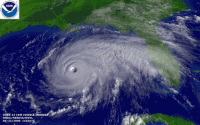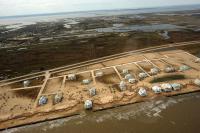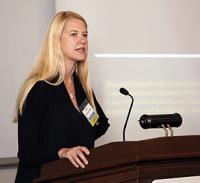-
Assessing climate change vulnerability in urban America
Impacts of climate change – rising sea levels, heat waves, rising rates of diseases caused by ticks, fleas, and mosquitoes, and many more — will affect cities across the country. One of the first efforts systematically to assess how cities are preparing for climate change shows that city planners have yet fully to assess their vulnerability to climate change, leaving serious risks unaddressed. Most city planners have yet to prepare for climate-related risks and the consequences.
-
-
Hurricanes are worse – whether you believe it depends on experience, gender, and politics

Objective measurements of storm intensity show that North Atlantic hurricanes have grown more destructive in recent decades. But coastal residents’ views on the matter depend less on scientific fact and more on their gender, belief in climate change, and recent experience with hurricanes, according to a new study.
-
-
Underground radar locates post-Katrina damage

An innovative underground radar technology is helping a city of in south Louisiana to identify and document underground infrastructure damage that had gone undetected in the months and years following Hurricane Katrina. This radar technology is a pipe-penetrating scanning system based on a new technology called ultra-wide band (UWB) pulsed radar. UWB allows for the inspection of buried pipelines, tunnels, and culverts to detect fractures, quantify corrosion, and determine the presence of voids in the surrounding soil often caused by storm water leaks and flooding.
-
-
Pace of Earth’s warming “unprecedented in 1,000 years”: NASA
The warming of the planet is proceeding at a pace not experienced within the past 1,000 years, making it “very unlikely” to keep warming to 1.5 degrees Celsius – the goal agreed by nations at the Paris climate summit last December. Recent research found that continuing current levels of carbon dioxide emissions for just five more years will eliminate any chance of restraining temperatures to a 1.5C increase and avoid runaway climate change.
-
-
Italy’s deadly earthquake is the latest in a history of destruction
The Appenines region of central Italy has been struck by a deadly earthquake, with a magnitude of 6.2. This earthquake is no surprise. Italy is prone to earthquakes; it sits above the boundary of the African and European plates. The Appenines region’s earthquake history can be traced back over seven centuries. Within the region, there is excellent and continuously improving scientific information about the hazard. But the knowledge of the hazard has not always translated well into measures that directly reduce economic loss and fatalities in earthquakes. Numerous vulnerable buildings remain, and the recovery process is commonly plagued by long disruptions and inadequate government funding to recover rapidly. Both the 2009 L’Aquila earthquake and this most recent quake highlight just how important it is to translate hazard assessments into improving the resilience of infrastructure to strong shaking. The focus should remain on linking science, engineering and policy, this is often the biggest challenge globally.
-
-
Social media helps build a sense of community in the aftermath of disaster
After natural disasters communities rely heavily on local governments to provide the necessary resources and information to respond to such disasters, but these approaches are not well equipped to meeting individual needs. As a complement to traditional methods, social media can provide a more personalized resource as well as fostering a sense of community in response to the crisis.
-
-
Large-scale metamaterials could earthquake-proof buildings in tremor-prone regions
Metamaterials – artificial structures that exhibit extraordinary vibrational properties – could come to the rescue of regions threatened by earthquakes, according to new research. The study, performed by researchers in Europe and involving detailed computer simulations, shows that large-scale metamaterials can attenuate the energy and amplitude of harmful low-frequency vibrations associated with seismic shocks.
-
-
Can we get better at predicting earthquakes?
In the wake of the deadly earthquake, measuring 6.2, which rocked central Italy in the early hours of 24 August, questions again have been raised about whether earthquakes can be predicted. Fortunately, all earthquakes do not lead to disasters and, therefore, understanding where and why disasters are produced is the first goal of earthquake seismology. The first issue is thus one of semantics and objectives. Is the goal to predict an earthquake occurrence, predict ground motion due to an earthquake, or predict a disaster? In our efforts to better predict earthquakes, we have to be precise about the timescale: is it a prediction that an earthquake is imminent – that is, within seconds, hours, or even days before the shaking? Or that it is likely to happen within years or tens of years? There is hope that one day we could detect and monitor extremely slight changes in the rocks that would precede earthquakes – but this is still a long way from “prediction” of precisely when and where a disaster will occur. For now, knowing earthquakes is one way to live with them, to be prepared, to know the vulnerability of our communities and to adopt sound policies for earthquake-safe environments.
-
-
Optimizing choice of post-disaster recovery options by analyzing entire cities
Civic leaders and engineers are typically faced with a very large number of possible recovery options in the aftermath of a major catastrophic event, such as a hurricane or an earthquake. “If you are trying to solve a problem that has, say, ten possible outcomes — you can probably find a way to figure out which one is optimal; [b]ut what if the possible solutions number as high as 10 to the 120th power?” ask researchers. They have developed a versatile and novel technique which is the first to factor in so many elements, demonstrating its effectiveness on transportation network recovery in imagined post-earthquake San Diego.
-
-
Rising seas threaten 1.9 million U.S. homes with current value of $882 billion

Typically when we talk about “underwater” homes, we are referring to negative equity. But there is a more literal way a home can be underwater: Rising sea levels, and the flooding likely to come with them, could inundate millions of U.S. homes worth hundreds of billions of dollars. If sea levels rise as much as climate scientists predict by the year 2100, almost 300 U.S. cities would lose at least half their homes, and 36 U.S. cities would be completely lost. The total combined current value of all homes at risk of being underwater with a 6-feet rise in sea levels is $882 billion.
-
-
Suburban sprawl and poor preparation worsened flood damage in Louisiana
The proximate cause of this month’s extraordinary flooding in southeast Louisiana was a slow-moving storm system that dropped up to two feet of rain in the upper reaches of the Amite and Comite river basins, which drain southern Mississippi and flow into Lake Pontchartrain. There are parallels between the damage of current flooding and the damage caused by Katrina. In both cases, human decisions magnified the consequences of extreme natural events. Planning and permitting enabled development in areas that had experienced repeat floods, and agencies had failed to complete projects designed to mitigate flood damage before the storms hit. If there is one lesson we have learned about floods, it is that records are made to be broken. So in addition to planning for the last flood, we need to anticipate higher water than our current benchmarks.
-
-
Germany to unveil a civil defense plan calling on citizens to stockpile food, water
The German government will tell citizens to stockpile food and water in their homes in order to prepare for a terror attack or catastrophe. The German cabinet will on Wednesday debate an Interior Ministry report, called the “Concept for Civil Defense,” which, among other things will require the population to stockpile enough food ten days and water for five days.
-
-
Louisiana’s Cajun Navy shines light on growing value of boat rescuers

As we look at the devastating losses suffered by Louisiana communities from the recent flooding, one of the inspiring aspects to emerge from the disaster are the reports of the “Cajun Navy” – everyday residents in their boats checking on and rescuing family, friends, neighbors and even strangers in need. The efforts of the Cajun Navy, however, are not unusual. Indeed, one consolation of the disaster is the extent to which the informal responses by survivors bolster stressed and overburdened formal response systems. We must continue to learn the right lessons from disaster: that there is value of both planning and improvisation in disaster. That although citizens might sometimes make mistakes, they also enable the greatest of responses. That successful disaster response, in part, depends on a willingness of formal responders to acknowledge the capacities of our citizenry, be they mariners or farmers, welders or educators, or something else entirely.
-
-
Global warming would make most cities too hot, humid to host summer Olympics
The future of the summer Olympics may be in jeopardy because of rising heat and humidity due to climate change. By 2085, only eight Northern Hemisphere cities outside of Western Europe are likely to be cool enough to host the summer games. The authors considered only cities with at least 600,000 residents, the size considered necessary for hosting the games. Cities with elevations over a mile above sea level were omitted as such an altitude (for example, Mexico City in 1968) faced challenges of their own.
-
-
Center of U.S. tornado activity shifting east and south, possibly driven by climate change
Researchers have found that the center of tornado activity in the United States has shifted in recent decades, and this shift is possibly influenced by climate change. “This completely redefines annual tornado activity in the United States,” said one of the researchers. The data show evidence that the central area of annual tornado activity has moved from Oklahoma to Alabama.
-
More headlines
The long view
Strengthening School Violence Prevention
Violence by K-12 students is disturbingly common. Ensuring that schools have effective ways to identify and prevent such incidents is becoming increasingly important. Expanding intervention options and supporting K-12 school efforts in Behavioral Threat Assessment and Management (BTAM) would help.
Huge Areas May Face Possibly Fatal Heat Waves if Warming Continues
A new assessment warns that if Earth’s average temperature reaches 2 degrees C over the preindustrial average, widespread areas may become too hot during extreme heat events for many people to survive without artificial cooling.
Trump’s Cuts to Federal Wildfire Crews Could Have “Scary” Consequences
President Donald Trump’s moves to slash the federal workforce have gutted the ranks of wildland firefighters and support personnel, fire professionals warn, leaving communities to face deadly consequences when big blazes arrive this summer. States, tribes and fire chiefs are preparing for a fire season with minimal federal support.
